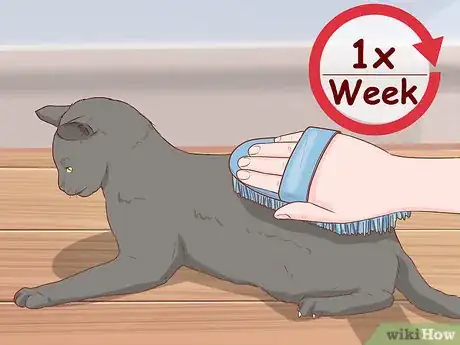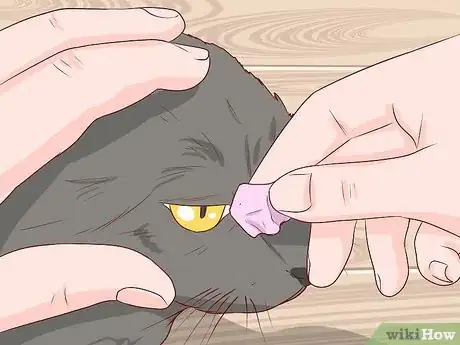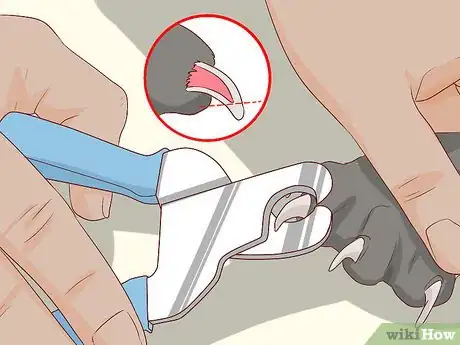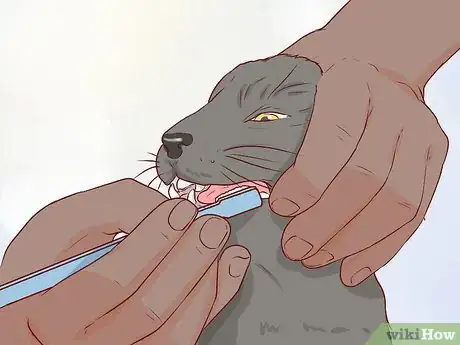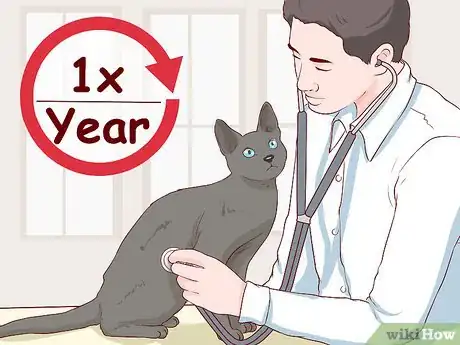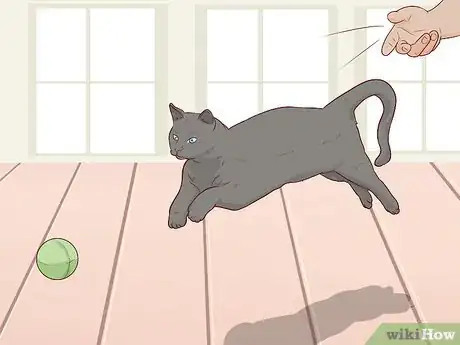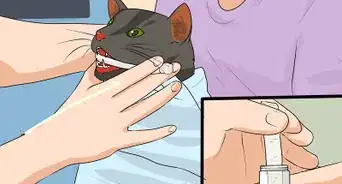This article was co-authored by Deanne Pawlisch, CVT, MA. Deanne Pawlisch is a Certified Veterinary Technician, who does corporate training for veterinary practices and has taught at the NAVTA-approved Veterinary Assistant Program at the Harper College in Illinois and in 2011 was elected to the board of the Veterinary Emergency and Critical Care Foundation. Deanne has been a Board Member of the Veterinary Emergency and Critical Care Foundation in San Antonio, Texas since 2011. She holds a BS in Anthropology from Loyola University and an MA in Anthropology from Northern Illinois University.
There are 9 references cited in this article, which can be found at the bottom of the page.
wikiHow marks an article as reader-approved once it receives enough positive feedback. In this case, 88% of readers who voted found the article helpful, earning it our reader-approved status.
This article has been viewed 27,557 times.
Bombay cats were originally a cross between American shorthairs and Burmese cats. The goal was to get a domestic house cat that looked somewhat like a small panther. These cats are hearty, and grooming them can be easier than grooming a long-haired cat. They are relatively healthy with a few exceptions. Because they are inquisitive, energetic cats, they do need some stimulation to be happy, but luckily, it doesn't take much to engage them.
Steps
Grooming a Bombay Cat
-
1Brush these cats on occasion. Bombay cats, with their sleek, soft fur, don't need much brushing. A once-a-week brushing is more than sufficient. Often, just petting is enough to remove the dead hair and help move oils around.[1]
-
2Wipe the cat's eyes regularly. The Bombay cat is prone to excessive tearing in the eyes, more so than other breeds. Tears can be irritating, so try to wipe down the corner of your cat's eyes at least once a day. Use a soft cloth dampened with warm water.[3]Advertisement
-
3Clean its ears. Bombays, like all cats, need their ears cleaned regularly. Clean them when you notice a buildup of wax on the inside. Ask your vet for a good cleaner, then use a cotton ball or swab moistened with that cleaner to gently bathe the inside of the cat's ears.[4]
-
4Clip the cat's claws. You also need to trim the cat's claws fairly regularly, such as twice a month or more often as needed. You'll notice when they start getting long; they'll be extra sharp, and the cat will keep getting them stuck in things.[5]
- Start by getting your cat used to having its feet handled and its claws extended. Then get it used to the noise of the clippers. You can practice on a piece of spaghetti with the cat nearby.
- When it comes time to trim, have the cat in your lap with its head away from you. Lift up one of its paws. Push gently on one of the cat's pads, extending the claw. Before trimming, make sure you can see the quick, the pink nerve and blood vessel inside the nail. Avoid clipping that.
- Remember your cat may become impatient. You may need to do its nails in more than one session.
-
5Brush your cat's teeth. Brushing your cat's teeth may sound like more than you bargained for when getting a cat. However, clean teeth are essential to a cat's good health, so it's an important step you should take regularly.[6]
- Start by getting your cat used to the idea. A couple of times a day, lift up the cat's gums, and gently rub them with your finger or a piece of gauze. Once your cat seems okay with this step, you can move on to brushing. Use a toothbrush and toothpaste specifically designed for cats.
- Give your cat a taste of the toothpaste. Apply a small amount to the toothbrush. Using the toothbrush, apply the paste to the teeth, reaching to the teeth in the back. Rub it in gently.
- While you're brushing, look to see if your cat's gums seem pink and healthy. Also check for any mouth wounds or broken teeth.
Maintaining a Bombay Cat's Health
-
1Pick a cat from a good breeder. If you're getting your cat from a breeder, make sure you choose a good one. The cats should be bred in the person's home and handled often. It can help to visit and see the place, as well as meet the kitten's mom and dad to see what they're like.[7]
- Ask for references and for a health guarantee in case the cat is born with congenital issues.[8]
-
2Watch for breathing difficulties. This cat has a relatively short snout. Because of that, the breed is more prone to problems with breathing, such as brachycephalic airway syndrome.[9] In mild cases, you may notice your cat breathes loudly or snores. In more severe cases, you may notice your cat only breathes through its mouth, tires easily, and may even pass out after playing.[10]
- If your cat passes out, take it to the vet immediately because it could be more than a breathing issue. For example, it could be a cardiac issue.
- Home treatments include helping your cat lose weight, keeping your cat inside, particularly when it's hot out, keeping stress down, and discouraging strenuous exercise.
- Your vet may also give your cat anti-inflammatories, corticosteroids, or oxygen treatments. If the condition is particularly severe, surgery may be needed to correct it.
-
3Get regular checkups. Like any cat, Bombay cats should be taken to the vet regularly for checkups (at least once a year). Cats often do not show symptoms of diseases until the diseases are advanced. Checkups help get your cat diagnosed more quickly, so that it can be treated.[11]
- For instance, like most cats, Bombays are susceptible to hypertrophic cardiomyopathy, which is a thickening of the heart walls. However, not all cats show symptoms of this disease, so it always needs to be diagnosed by a vet.
Keeping a Bombay Cat Happy
-
1Provide plenty of engaging toys. Bombays are smart cats, so they need to be entertained more than some other cats. Have plenty of toys on hand to keep your cat happy, such as puzzle toys and other engaging toys.[12]
-
2Play with your cat. While your Bombay will likely find ways to entertain itself, it will also enjoy playing with you. In fact, you may even get this cat to play fetch, since it enjoys interactive activities so much. You can also use stick toys with lures or fleece strips on the end to entertain your cat.[15]
-
3Give it warm places to snuggle up. Most cats like warmth, but Bombays are particularly partial to warm spots. Make sure you provide plenty of warm spots, such as cat beds in sunny windows, to help keep your kitty happy.[16]
-
4Try leash training. Because Bombays are so smart and engaged, they take more readily to leash training than some other breeds. It's best to start young, though, as the cat will take to training more easily when it is a kitten than when it's older. Cats should only be trained using positive methods, so don't punish your cat.[19]
- Start with just a harness worn while the cat is supervised. A cat can slip out of a collar. Let the cat wear the harness around the house to get used to it, but make sure that you are watching the cat to prevent it from getting injured if the harness gets hung on something.
- Take the cat outside on short explorations. Stay close to the house at first, as it will feel safer. In fact, just hanging out with the cat in the yard will help your cat adjust. Some cats may never get used to being outside.
- Work up to trying short walks. Remember, your idea of a walk may not be your cat's idea of a walk.
References
- ↑ http://cattime.com/cat-breeds/bombay-cats#/slide/1
- ↑ http://www.vetstreet.com/cats/bombay#grooming
- ↑ http://cattime.com/cat-breeds/bombay-cats#/slide/1
- ↑ http://www.vetstreet.com/cats/bombay#grooming
- ↑ http://www.aspca.org/pet-care/cat-care/cat-grooming-tips
- ↑ http://www.aspca.org/pet-care/cat-care/cat-grooming-tips
- ↑ http://www.vetstreet.com/cats/bombay#personality
- ↑ http://www.vetstreet.com/cats/bombay#health
- ↑ http://www.vetstreet.com/cats/bombay#health
- ↑ https://vcahospitals.com/know-your-pet/brachycephalic-airway-syndrome-in-cats
- ↑ http://www.vetstreet.com/cats/bombay#health
- ↑ http://cattime.com/cat-breeds/bombay-cats#/slide/1
- ↑ http://www.vetstreet.com/cats/bombay#personality
- ↑ http://www.hillspet.com/en/us/cat-breeds/bombay
- ↑ http://cattime.com/cat-breeds/bombay-cats#/slide/1
- ↑ http://cattime.com/cat-breeds/bombay-cats#/slide/1
- ↑ http://www.hillspet.com/en/us/cat-breeds/bombay
- ↑ http://www.vetstreet.com/cats/bombay#personality
- ↑ http://cfa.org/Breeds/BreedsAB/Bombay.aspx
About This Article
To care for your Bombay cat, take it to the vet at least once per year for checkups to make sure it is in good health. Bombay cats are prone to breathing problems because of their short snouts, so take it to the vet if you notice it struggling with breathing or if it passes out. You should clip your cat’s claws around twice per month to prevent them from getting caught on things, which can be painful to your cat. To keep your cat happy and entertained, play with it every day. You can use stick toys with lures or teach your cat to play fetch with a small toy mouse. For extra fun, try leash training your cat so you can take it outside for walks. Bombay cats are very smart and active, so they are more likely than other cat breeds to enjoy being walked with a leash. For more tips from our Veterinary co-author, like how to brush your cat’s teeth, keep reading!
